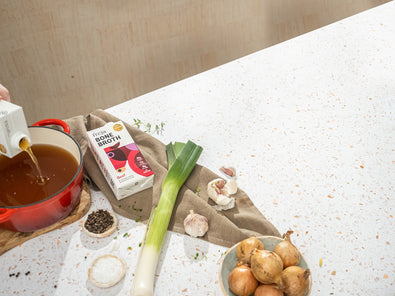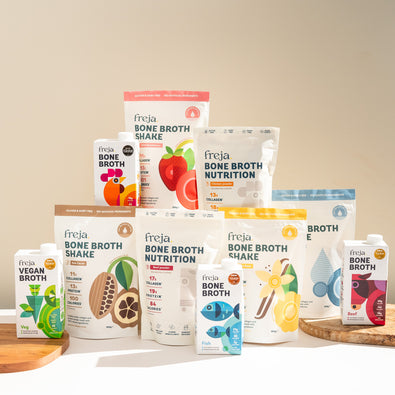Have you ever asked yourself, what’s the difference between stock and bone broth? Comparing bone broth vs stock is something that be confusing, particularly as people use lots of different terminologies.
However, both bone broth and stock can be incredibly nutritious and delicious dishes or additions to your recipes – and to make the most of them, you need to know the main features of each. With this thought in mind, we’re looking at some of the main differences between bone broth and stock to help you find the ideal option for your cooking.
What's the Difference Between Stock and Broth?
It’s not always straightforward to define the main difference between stock and broth, since both of these recipes focus on simmering ingredients to draw out their flavours. However, the main difference between stock and broth is generally in terms of the technique used in their preparation, and what you can and can’t add to a bone broth.
What is Stock?
Stock is a liquid derivative that, in theory, is produced by simmering bones (sometimes along with other ingredients, such as vegetables) for a few hours. If stock is made the correct way, then usually, the bones used are simmered in hot water for several hours to bring out their full flavours. However, the reality is that most commercially bought cooking stock is mainly a mixture of salt, sugar, colourings, flavourings and yeast.
What is Broth?
A broth is very similar to stock, since it is made by slowly simmering ingredients over a long period of time in hot water. However, most broths focus on simmering meats and vegetables rather than solely using bones to create their flavour profile. Broths are commonly also flavoured with herbs, spices, salt, or pepper to help draw out the flavours and create a more well-rounded dish.
What is Bone Broth?
Bone broth, as we define it, is a clear liquid, meat-based stock, that has been simmered for an extra length of time, to ensure extra nutrients are released. A true bone broth should never have any additives, and should consist only of meaty bones and vegetables - and not containing any yeast, added fats, or flavourings.
Bone Broth vs Stock: Is Bone Broth the Same as Stock?
It’s easy to assume that “bone broth vs stock” is a trick question since they appear to be made from very similar ingredients. However, one of the main differences between stock and bone broth is that the former uses bones stripped of all the meat. By contrast, bone broth uses still-meaty bones, giving a more rounded flavour and a thicker texture.
Moreover, most bone broths will also include several additional ingredients to help make a delicious dish, such as onions, vegetables, and seasonings/herbs. This generally makes bone broth a delicious dish in its own right, whereas stock is primarily used for cooking.
Can I Use Bone Broth Instead of Stock?
If your normal recipe calls for stock, there’s some great news: they can be used interchangeably when cooking. However, you should always remember that there is a significant flavour difference between bone broth and stock.
As such, bone broth is much richer than stock; therefore, if you attempt to use bone broth in your recipes that normally use stock, the final result will likely be much richer. The same is also true in reverse; switching out bone broth for stock will result in a much milder dish. As such, if you decide to use bone broth instead of stock, be sure to consider how strong you’d like the final dish and adjust your cooking accordingly.
For us, though, we absolutely love the rich flavour that bone broth brings to cooking. It is much heartier than a typical bone stock, giving every dish a more robust finish that’s hard not to love!
Tips for Using Bone Broth in Your Cooking
If you want to use bone broth in your cooking rather than stock, it is important to remember that broth and stock are not quite the same. As such, you may need to make some adjustments. The following tips may help you use bone broth successfully in your cooking going forwards:
- Choose the right type of bone broth! There are countless different bone broths available, so be sure to choose one that matches your recipe. For example, if you’re making a fish dish, you’ll want to definitely opt for a fish bone broth (and so on).
- Keep in mind: bone broth is deliciously rich in flavour – which means you won’t need to add as many extra ingredients to make your recipes amazing.
- If you are cooking with Take Stock Bone Broth, bear in mind that our broths contain around 0.6g of salt per 100g. This makes them relatively low in salt in relation to many comparable brands and cooking stocks. Be sure to taste your food when cooking and even add a pinch more salt, if required.
- Don’t be afraid to try a vegan broth! Our unique vegan broth is designed to offer a delicious flavour, as with our bone broths – but without the meat! So, if you’re catering for a vegan / vegetarian audience, it might just be an excellent option to consider. It’s also easy to pair with meat dishes too if you are concerned about overpowering the flavour of the meat.
- Serve it piping hot! There’s nothing more comforting (if you ask us) the a piping hot bowl of bone broth – or bone broth cooking – especially when the weather turns cold.
Final Thoughts
If you’ve been feeling a little unsure about what the difference is between stock and bone broth, don’t worry – we’ve got you covered. Bone broth is generally far richer in flavour and nutrients vs stock, since stock is only simmered for a few hours. By contrast, as bone broths use meaty bones, and are simmered for a much longer period of time, there’s even more flavour packed in.
So, why not try something new for your cooking? Now you know the difference between stock and broth, our delicious bone broths could add a lot of meaty flavour to your favourite recipes!





















